Economic Report: Market Structure Analysis of Toyota Corporation
VerifiedAdded on 2021/05/30
|12
|1994
|737
Report
AI Summary
This economics assignment analyzes the market structure of Toyota, focusing on its position within the automotive industry. The report identifies the industry as an oligopoly, detailing key players and market share dynamics. It examines Toyota's product offerings, including vehicles and financial services, classifying its products as private goods. The analysis covers the automotive industry's overview, including global and US production trends. The report delves into Toyota's operational and strategic approaches, such as its lean manufacturing system, ownership structure, and marketing strategies, which include market segmentation, targeting, and positioning. It also evaluates Toyota's customer service and sales strategies, emphasizing its distribution channels and customer-centric approach. The report concludes by summarizing Toyota's strategies within the oligopolistic market structure, highlighting the importance of market segmentation, product differentiation, and brand promotion.
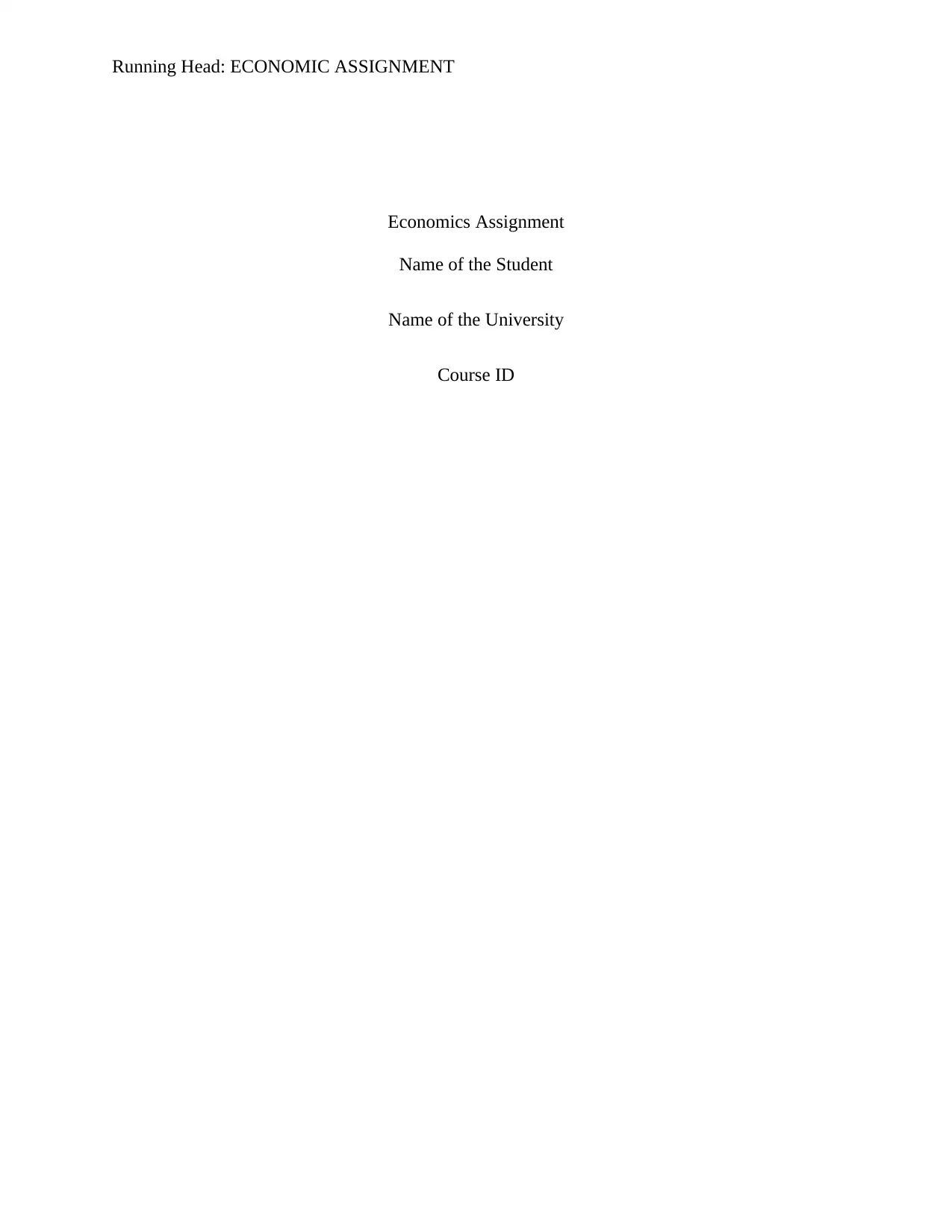
Running Head: ECONOMIC ASSIGNMENT
Economics Assignment
Name of the Student
Name of the University
Course ID
Economics Assignment
Name of the Student
Name of the University
Course ID
Paraphrase This Document
Need a fresh take? Get an instant paraphrase of this document with our AI Paraphraser
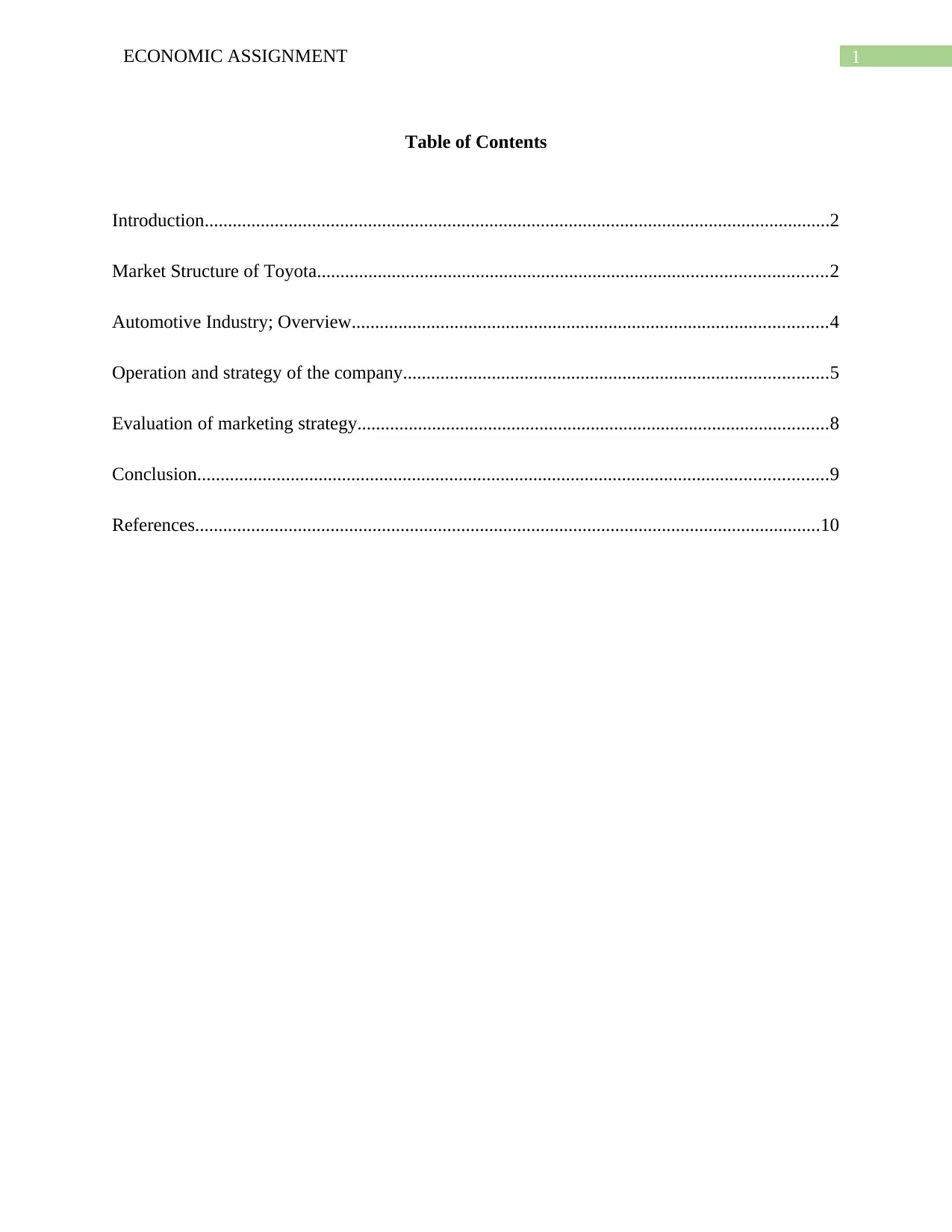
1ECONOMIC ASSIGNMENT
Table of Contents
Introduction......................................................................................................................................2
Market Structure of Toyota.............................................................................................................2
Automotive Industry; Overview......................................................................................................4
Operation and strategy of the company...........................................................................................5
Evaluation of marketing strategy.....................................................................................................8
Conclusion.......................................................................................................................................9
References......................................................................................................................................10
Table of Contents
Introduction......................................................................................................................................2
Market Structure of Toyota.............................................................................................................2
Automotive Industry; Overview......................................................................................................4
Operation and strategy of the company...........................................................................................5
Evaluation of marketing strategy.....................................................................................................8
Conclusion.......................................................................................................................................9
References......................................................................................................................................10
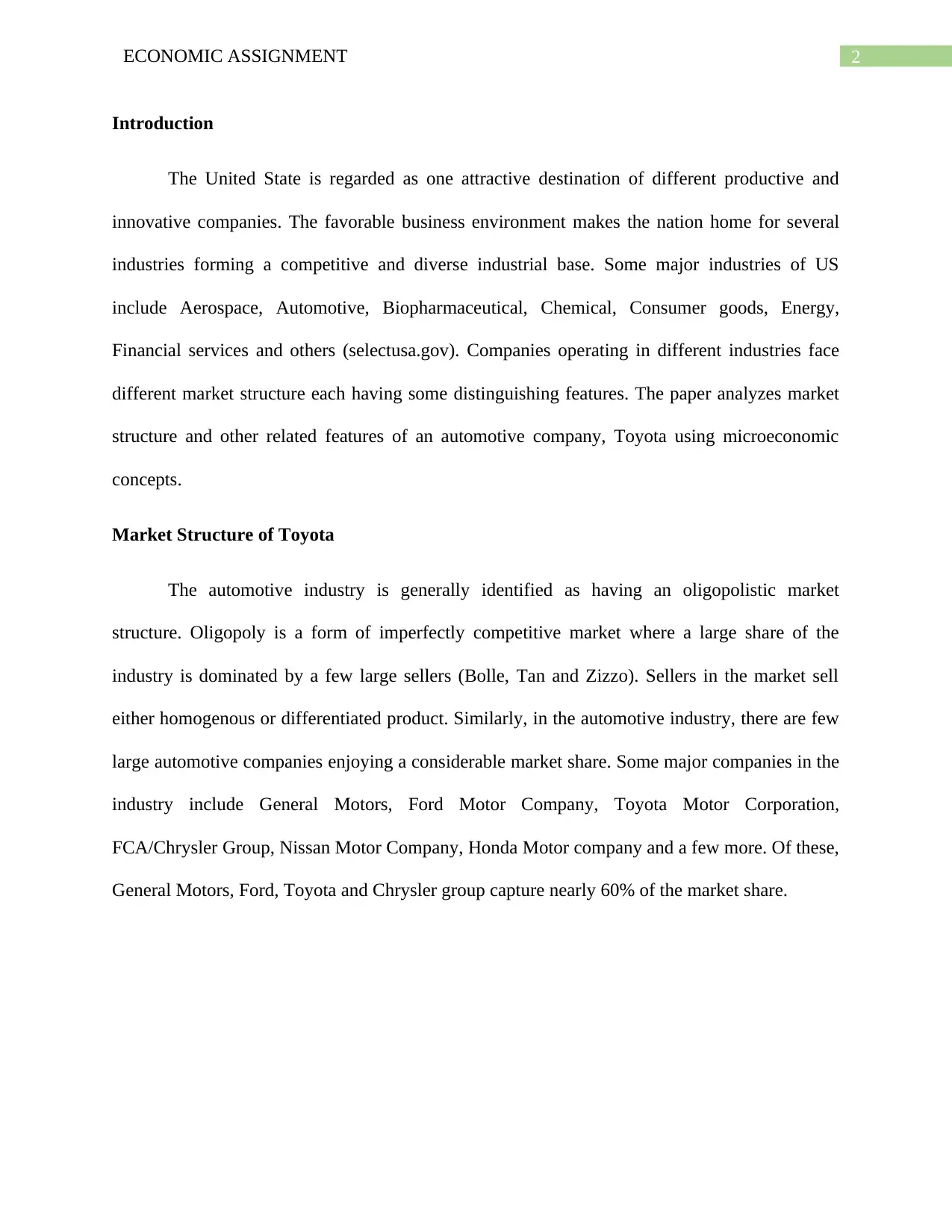
2ECONOMIC ASSIGNMENT
Introduction
The United State is regarded as one attractive destination of different productive and
innovative companies. The favorable business environment makes the nation home for several
industries forming a competitive and diverse industrial base. Some major industries of US
include Aerospace, Automotive, Biopharmaceutical, Chemical, Consumer goods, Energy,
Financial services and others (selectusa.gov). Companies operating in different industries face
different market structure each having some distinguishing features. The paper analyzes market
structure and other related features of an automotive company, Toyota using microeconomic
concepts.
Market Structure of Toyota
The automotive industry is generally identified as having an oligopolistic market
structure. Oligopoly is a form of imperfectly competitive market where a large share of the
industry is dominated by a few large sellers (Bolle, Tan and Zizzo). Sellers in the market sell
either homogenous or differentiated product. Similarly, in the automotive industry, there are few
large automotive companies enjoying a considerable market share. Some major companies in the
industry include General Motors, Ford Motor Company, Toyota Motor Corporation,
FCA/Chrysler Group, Nissan Motor Company, Honda Motor company and a few more. Of these,
General Motors, Ford, Toyota and Chrysler group capture nearly 60% of the market share.
Introduction
The United State is regarded as one attractive destination of different productive and
innovative companies. The favorable business environment makes the nation home for several
industries forming a competitive and diverse industrial base. Some major industries of US
include Aerospace, Automotive, Biopharmaceutical, Chemical, Consumer goods, Energy,
Financial services and others (selectusa.gov). Companies operating in different industries face
different market structure each having some distinguishing features. The paper analyzes market
structure and other related features of an automotive company, Toyota using microeconomic
concepts.
Market Structure of Toyota
The automotive industry is generally identified as having an oligopolistic market
structure. Oligopoly is a form of imperfectly competitive market where a large share of the
industry is dominated by a few large sellers (Bolle, Tan and Zizzo). Sellers in the market sell
either homogenous or differentiated product. Similarly, in the automotive industry, there are few
large automotive companies enjoying a considerable market share. Some major companies in the
industry include General Motors, Ford Motor Company, Toyota Motor Corporation,
FCA/Chrysler Group, Nissan Motor Company, Honda Motor company and a few more. Of these,
General Motors, Ford, Toyota and Chrysler group capture nearly 60% of the market share.
⊘ This is a preview!⊘
Do you want full access?
Subscribe today to unlock all pages.

Trusted by 1+ million students worldwide
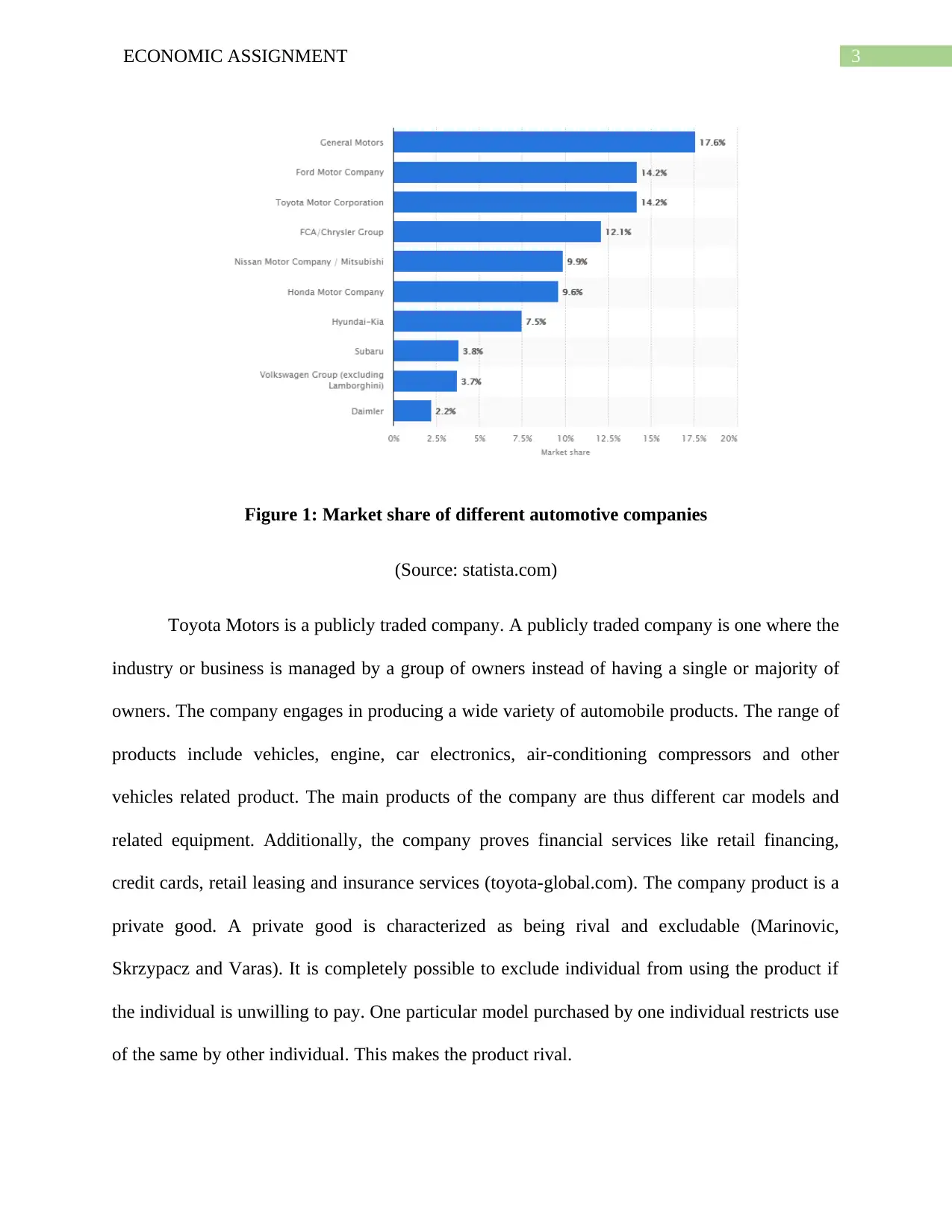
3ECONOMIC ASSIGNMENT
Figure 1: Market share of different automotive companies
(Source: statista.com)
Toyota Motors is a publicly traded company. A publicly traded company is one where the
industry or business is managed by a group of owners instead of having a single or majority of
owners. The company engages in producing a wide variety of automobile products. The range of
products include vehicles, engine, car electronics, air-conditioning compressors and other
vehicles related product. The main products of the company are thus different car models and
related equipment. Additionally, the company proves financial services like retail financing,
credit cards, retail leasing and insurance services (toyota-global.com). The company product is a
private good. A private good is characterized as being rival and excludable (Marinovic,
Skrzypacz and Varas). It is completely possible to exclude individual from using the product if
the individual is unwilling to pay. One particular model purchased by one individual restricts use
of the same by other individual. This makes the product rival.
Figure 1: Market share of different automotive companies
(Source: statista.com)
Toyota Motors is a publicly traded company. A publicly traded company is one where the
industry or business is managed by a group of owners instead of having a single or majority of
owners. The company engages in producing a wide variety of automobile products. The range of
products include vehicles, engine, car electronics, air-conditioning compressors and other
vehicles related product. The main products of the company are thus different car models and
related equipment. Additionally, the company proves financial services like retail financing,
credit cards, retail leasing and insurance services (toyota-global.com). The company product is a
private good. A private good is characterized as being rival and excludable (Marinovic,
Skrzypacz and Varas). It is completely possible to exclude individual from using the product if
the individual is unwilling to pay. One particular model purchased by one individual restricts use
of the same by other individual. This makes the product rival.
Paraphrase This Document
Need a fresh take? Get an instant paraphrase of this document with our AI Paraphraser
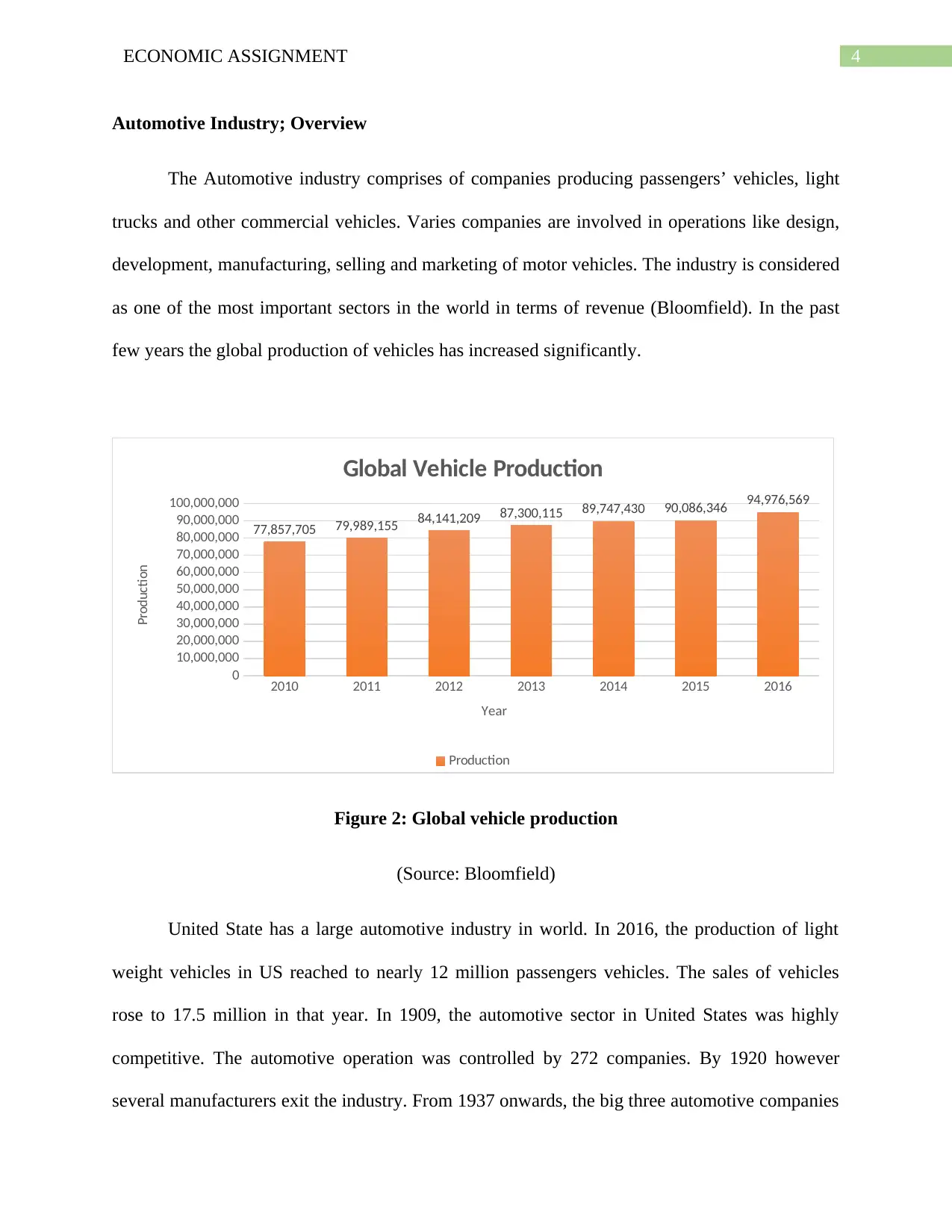
4ECONOMIC ASSIGNMENT
Automotive Industry; Overview
The Automotive industry comprises of companies producing passengers’ vehicles, light
trucks and other commercial vehicles. Varies companies are involved in operations like design,
development, manufacturing, selling and marketing of motor vehicles. The industry is considered
as one of the most important sectors in the world in terms of revenue (Bloomfield). In the past
few years the global production of vehicles has increased significantly.
2010 2011 2012 2013 2014 2015 2016
0
10,000,000
20,000,000
30,000,000
40,000,000
50,000,000
60,000,000
70,000,000
80,000,000
90,000,000
100,000,000
77,857,705 79,989,155 84,141,209 87,300,115 89,747,430 90,086,346 94,976,569
Global Vehicle Production
Production
Year
Production
Figure 2: Global vehicle production
(Source: Bloomfield)
United State has a large automotive industry in world. In 2016, the production of light
weight vehicles in US reached to nearly 12 million passengers vehicles. The sales of vehicles
rose to 17.5 million in that year. In 1909, the automotive sector in United States was highly
competitive. The automotive operation was controlled by 272 companies. By 1920 however
several manufacturers exit the industry. From 1937 onwards, the big three automotive companies
Automotive Industry; Overview
The Automotive industry comprises of companies producing passengers’ vehicles, light
trucks and other commercial vehicles. Varies companies are involved in operations like design,
development, manufacturing, selling and marketing of motor vehicles. The industry is considered
as one of the most important sectors in the world in terms of revenue (Bloomfield). In the past
few years the global production of vehicles has increased significantly.
2010 2011 2012 2013 2014 2015 2016
0
10,000,000
20,000,000
30,000,000
40,000,000
50,000,000
60,000,000
70,000,000
80,000,000
90,000,000
100,000,000
77,857,705 79,989,155 84,141,209 87,300,115 89,747,430 90,086,346 94,976,569
Global Vehicle Production
Production
Year
Production
Figure 2: Global vehicle production
(Source: Bloomfield)
United State has a large automotive industry in world. In 2016, the production of light
weight vehicles in US reached to nearly 12 million passengers vehicles. The sales of vehicles
rose to 17.5 million in that year. In 1909, the automotive sector in United States was highly
competitive. The automotive operation was controlled by 272 companies. By 1920 however
several manufacturers exit the industry. From 1937 onwards, the big three automotive companies
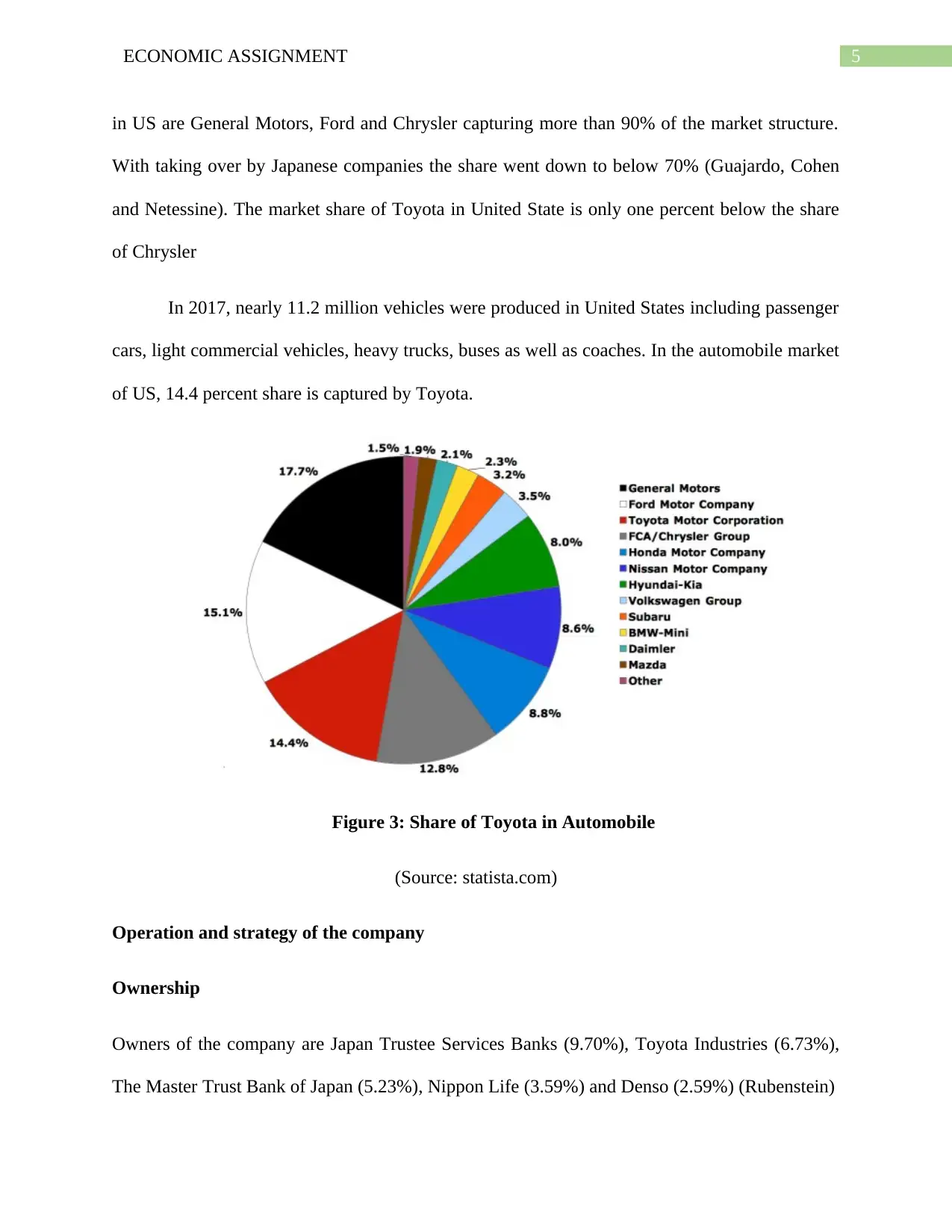
5ECONOMIC ASSIGNMENT
in US are General Motors, Ford and Chrysler capturing more than 90% of the market structure.
With taking over by Japanese companies the share went down to below 70% (Guajardo, Cohen
and Netessine). The market share of Toyota in United State is only one percent below the share
of Chrysler
In 2017, nearly 11.2 million vehicles were produced in United States including passenger
cars, light commercial vehicles, heavy trucks, buses as well as coaches. In the automobile market
of US, 14.4 percent share is captured by Toyota.
Figure 3: Share of Toyota in Automobile
(Source: statista.com)
Operation and strategy of the company
Ownership
Owners of the company are Japan Trustee Services Banks (9.70%), Toyota Industries (6.73%),
The Master Trust Bank of Japan (5.23%), Nippon Life (3.59%) and Denso (2.59%) (Rubenstein)
in US are General Motors, Ford and Chrysler capturing more than 90% of the market structure.
With taking over by Japanese companies the share went down to below 70% (Guajardo, Cohen
and Netessine). The market share of Toyota in United State is only one percent below the share
of Chrysler
In 2017, nearly 11.2 million vehicles were produced in United States including passenger
cars, light commercial vehicles, heavy trucks, buses as well as coaches. In the automobile market
of US, 14.4 percent share is captured by Toyota.
Figure 3: Share of Toyota in Automobile
(Source: statista.com)
Operation and strategy of the company
Ownership
Owners of the company are Japan Trustee Services Banks (9.70%), Toyota Industries (6.73%),
The Master Trust Bank of Japan (5.23%), Nippon Life (3.59%) and Denso (2.59%) (Rubenstein)
⊘ This is a preview!⊘
Do you want full access?
Subscribe today to unlock all pages.

Trusted by 1+ million students worldwide

6ECONOMIC ASSIGNMENT
Overall operation
Toyota Motors set a broad set of strategy for successful operation in the global market. The
company focuses on exclusive design of goods and service. The strategic decision is taken based
on innovation and technological advancement. The second important area of operation is quality
management. Quality is one important aspect of Toyota Production System (TPS). Other
operations of the organization include location strategy, job design and human resources, supply
chain management and inventory management (toyota-global.com).
Production
The production system of Toyota Motor Corporation is known as the “lean
manufacturing system” or “Just-in Time” system. The Toyota Production System (TPS) is built
on two concepts, the first is termed as Jidoka which refers to the system designed in a such a way
that production process stops immediate after occurrence of a problem. This helps to prevent
production of defective product (Bloomfield 2017). The Just in time system in one where each
process is designed to deliver only items required for the next process in a continuous flow.
Marketing strategy
The major elements of Toyota’s marketing strategy include market segmentation,
targeting and positioning.
Market segmentation
The company currently divides its operation into two groups. The first is demographic
and the second one is psychographic. In demographic segmentation the company mainly target
upper middle income group. Different car models offered in this segment include Land Cruiser,
Overall operation
Toyota Motors set a broad set of strategy for successful operation in the global market. The
company focuses on exclusive design of goods and service. The strategic decision is taken based
on innovation and technological advancement. The second important area of operation is quality
management. Quality is one important aspect of Toyota Production System (TPS). Other
operations of the organization include location strategy, job design and human resources, supply
chain management and inventory management (toyota-global.com).
Production
The production system of Toyota Motor Corporation is known as the “lean
manufacturing system” or “Just-in Time” system. The Toyota Production System (TPS) is built
on two concepts, the first is termed as Jidoka which refers to the system designed in a such a way
that production process stops immediate after occurrence of a problem. This helps to prevent
production of defective product (Bloomfield 2017). The Just in time system in one where each
process is designed to deliver only items required for the next process in a continuous flow.
Marketing strategy
The major elements of Toyota’s marketing strategy include market segmentation,
targeting and positioning.
Market segmentation
The company currently divides its operation into two groups. The first is demographic
and the second one is psychographic. In demographic segmentation the company mainly target
upper middle income group. Different car models offered in this segment include Land Cruiser,
Paraphrase This Document
Need a fresh take? Get an instant paraphrase of this document with our AI Paraphraser

7ECONOMIC ASSIGNMENT
Camry and Parado. In the second segment, the targeted population belongs to high income class.
Car models for this group include Toyota Altis, Sports model and Toyota Fortuner.
Targeting
A differentiated targeting strategy is used by the company for manufacturing and selling
its car models to different customer segments.
Positioning
Toyota uses a positioning strategy that is based on value and users’ benefits. By this
strategy the company aims to highlight different functional benefits of its own product.
Toyota uses various promotional strategies as part of their marketing strategy. The
company advertise their models in different media such as newspaper, radio. television,
billboards, internet, word of mouth, yellow pages and billboard (Rubenstein). The company
offers a cashback to attract more customers. The cash back offers given by the company to dealer
and customer enjoy it as an instant rebate. This particularly helps to attract non-cash buyers.
Sales strategy
Toyota successfully uses its distribution channel. Toyota sales different models of
vehicles through dealership. A Toyota dealer in turn depends on the parent company for
designing cars according to customers need. The sales staffs are engaged in selling different
models on one to one basis. In the dealership works the staff members together work as a team.
The sales staffs are not only highly skilled in sales but also are efficient in collecting data,
maintaining information, taking orders from customers and financing insurance (nytimes.com).
Camry and Parado. In the second segment, the targeted population belongs to high income class.
Car models for this group include Toyota Altis, Sports model and Toyota Fortuner.
Targeting
A differentiated targeting strategy is used by the company for manufacturing and selling
its car models to different customer segments.
Positioning
Toyota uses a positioning strategy that is based on value and users’ benefits. By this
strategy the company aims to highlight different functional benefits of its own product.
Toyota uses various promotional strategies as part of their marketing strategy. The
company advertise their models in different media such as newspaper, radio. television,
billboards, internet, word of mouth, yellow pages and billboard (Rubenstein). The company
offers a cashback to attract more customers. The cash back offers given by the company to dealer
and customer enjoy it as an instant rebate. This particularly helps to attract non-cash buyers.
Sales strategy
Toyota successfully uses its distribution channel. Toyota sales different models of
vehicles through dealership. A Toyota dealer in turn depends on the parent company for
designing cars according to customers need. The sales staffs are engaged in selling different
models on one to one basis. In the dealership works the staff members together work as a team.
The sales staffs are not only highly skilled in sales but also are efficient in collecting data,
maintaining information, taking orders from customers and financing insurance (nytimes.com).
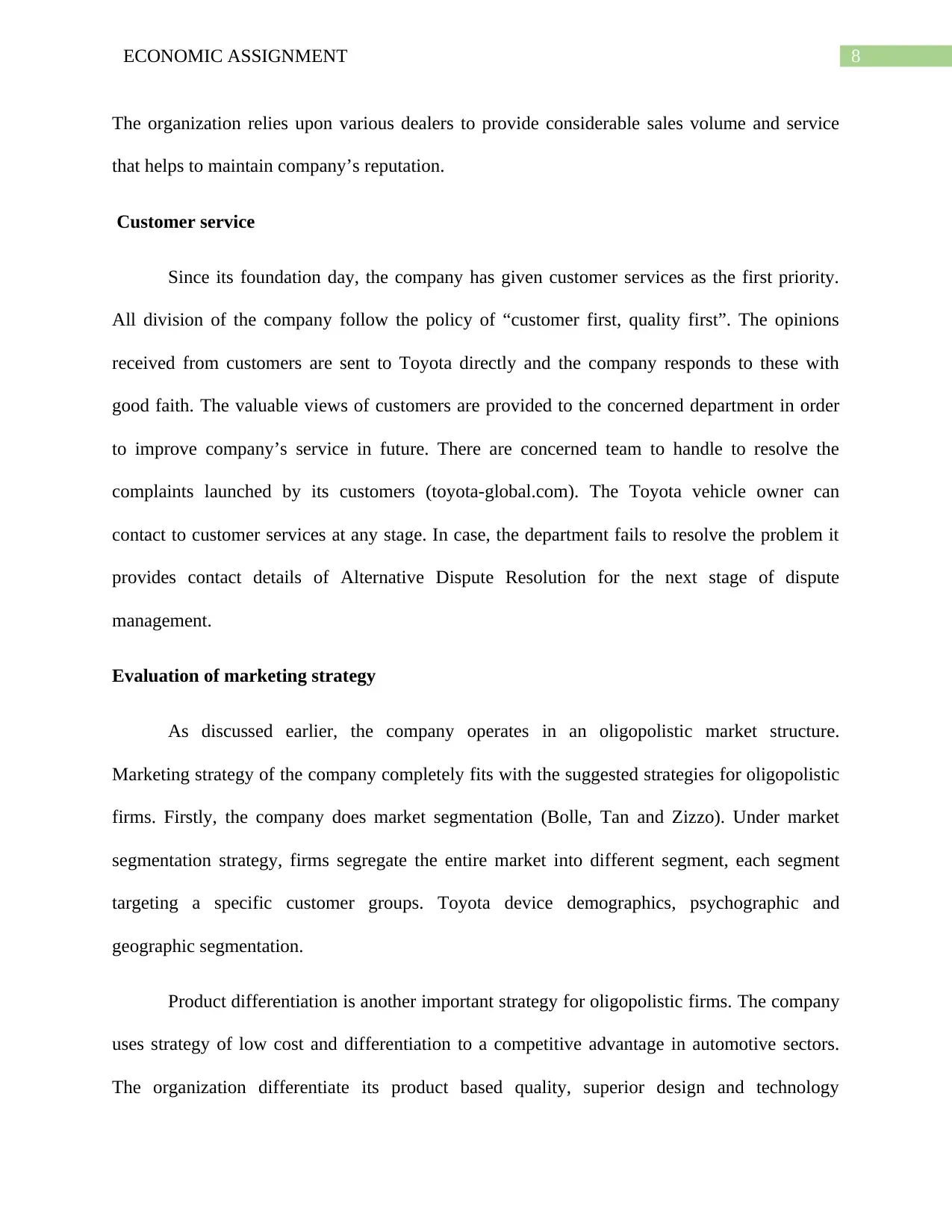
8ECONOMIC ASSIGNMENT
The organization relies upon various dealers to provide considerable sales volume and service
that helps to maintain company’s reputation.
Customer service
Since its foundation day, the company has given customer services as the first priority.
All division of the company follow the policy of “customer first, quality first”. The opinions
received from customers are sent to Toyota directly and the company responds to these with
good faith. The valuable views of customers are provided to the concerned department in order
to improve company’s service in future. There are concerned team to handle to resolve the
complaints launched by its customers (toyota-global.com). The Toyota vehicle owner can
contact to customer services at any stage. In case, the department fails to resolve the problem it
provides contact details of Alternative Dispute Resolution for the next stage of dispute
management.
Evaluation of marketing strategy
As discussed earlier, the company operates in an oligopolistic market structure.
Marketing strategy of the company completely fits with the suggested strategies for oligopolistic
firms. Firstly, the company does market segmentation (Bolle, Tan and Zizzo). Under market
segmentation strategy, firms segregate the entire market into different segment, each segment
targeting a specific customer groups. Toyota device demographics, psychographic and
geographic segmentation.
Product differentiation is another important strategy for oligopolistic firms. The company
uses strategy of low cost and differentiation to a competitive advantage in automotive sectors.
The organization differentiate its product based quality, superior design and technology
The organization relies upon various dealers to provide considerable sales volume and service
that helps to maintain company’s reputation.
Customer service
Since its foundation day, the company has given customer services as the first priority.
All division of the company follow the policy of “customer first, quality first”. The opinions
received from customers are sent to Toyota directly and the company responds to these with
good faith. The valuable views of customers are provided to the concerned department in order
to improve company’s service in future. There are concerned team to handle to resolve the
complaints launched by its customers (toyota-global.com). The Toyota vehicle owner can
contact to customer services at any stage. In case, the department fails to resolve the problem it
provides contact details of Alternative Dispute Resolution for the next stage of dispute
management.
Evaluation of marketing strategy
As discussed earlier, the company operates in an oligopolistic market structure.
Marketing strategy of the company completely fits with the suggested strategies for oligopolistic
firms. Firstly, the company does market segmentation (Bolle, Tan and Zizzo). Under market
segmentation strategy, firms segregate the entire market into different segment, each segment
targeting a specific customer groups. Toyota device demographics, psychographic and
geographic segmentation.
Product differentiation is another important strategy for oligopolistic firms. The company
uses strategy of low cost and differentiation to a competitive advantage in automotive sectors.
The organization differentiate its product based quality, superior design and technology
⊘ This is a preview!⊘
Do you want full access?
Subscribe today to unlock all pages.

Trusted by 1+ million students worldwide
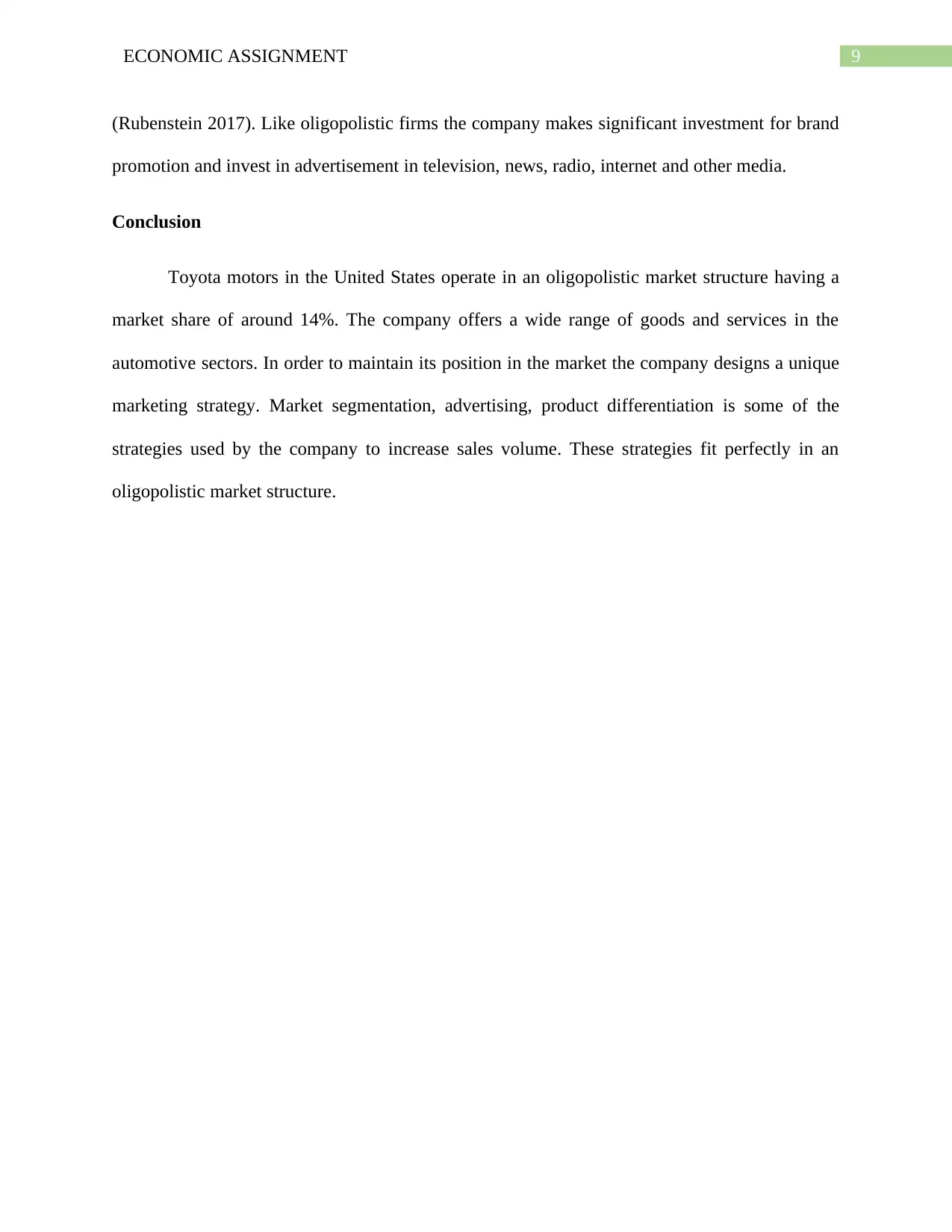
9ECONOMIC ASSIGNMENT
(Rubenstein 2017). Like oligopolistic firms the company makes significant investment for brand
promotion and invest in advertisement in television, news, radio, internet and other media.
Conclusion
Toyota motors in the United States operate in an oligopolistic market structure having a
market share of around 14%. The company offers a wide range of goods and services in the
automotive sectors. In order to maintain its position in the market the company designs a unique
marketing strategy. Market segmentation, advertising, product differentiation is some of the
strategies used by the company to increase sales volume. These strategies fit perfectly in an
oligopolistic market structure.
(Rubenstein 2017). Like oligopolistic firms the company makes significant investment for brand
promotion and invest in advertisement in television, news, radio, internet and other media.
Conclusion
Toyota motors in the United States operate in an oligopolistic market structure having a
market share of around 14%. The company offers a wide range of goods and services in the
automotive sectors. In order to maintain its position in the market the company designs a unique
marketing strategy. Market segmentation, advertising, product differentiation is some of the
strategies used by the company to increase sales volume. These strategies fit perfectly in an
oligopolistic market structure.
Paraphrase This Document
Need a fresh take? Get an instant paraphrase of this document with our AI Paraphraser
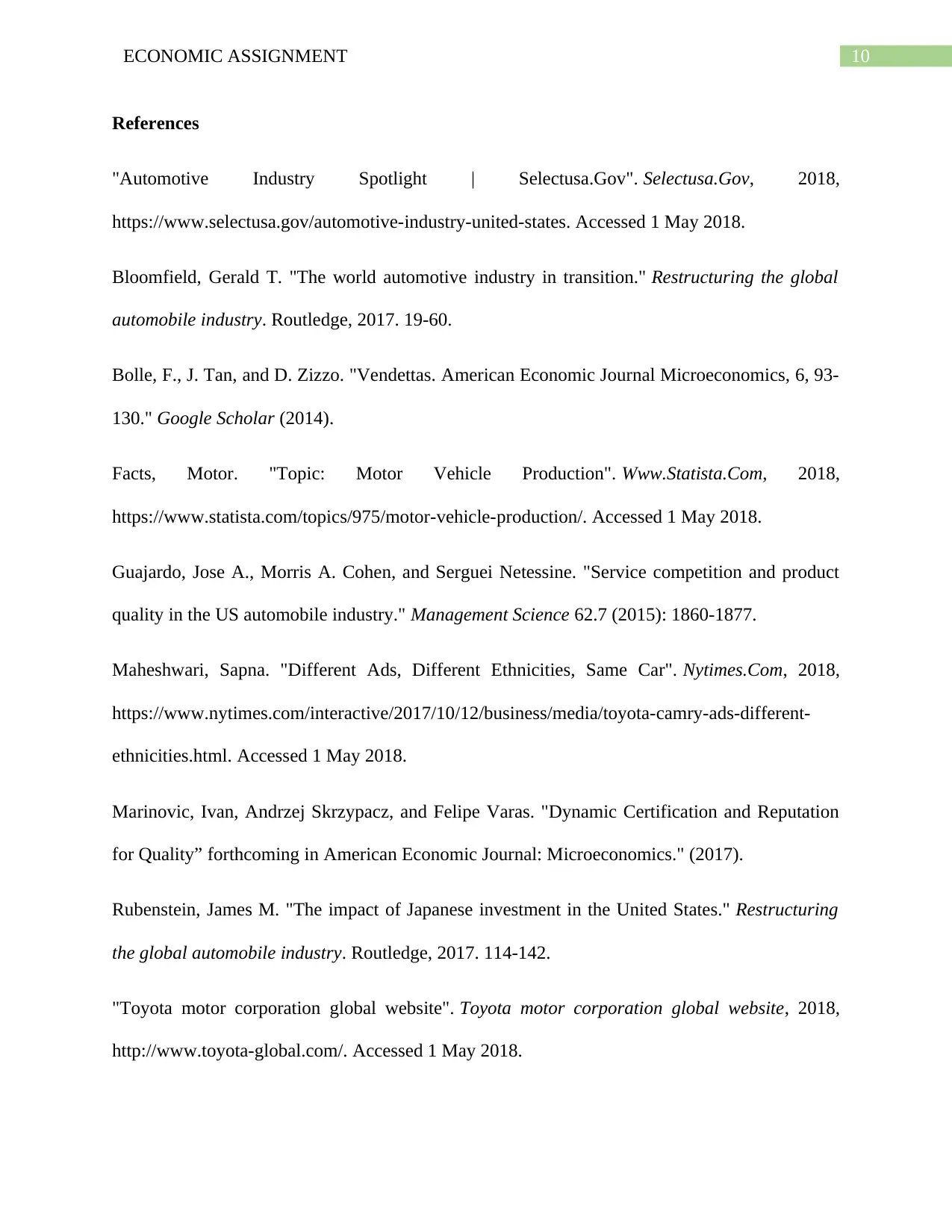
10ECONOMIC ASSIGNMENT
References
"Automotive Industry Spotlight | Selectusa.Gov". Selectusa.Gov, 2018,
https://www.selectusa.gov/automotive-industry-united-states. Accessed 1 May 2018.
Bloomfield, Gerald T. "The world automotive industry in transition." Restructuring the global
automobile industry. Routledge, 2017. 19-60.
Bolle, F., J. Tan, and D. Zizzo. "Vendettas. American Economic Journal Microeconomics, 6, 93-
130." Google Scholar (2014).
Facts, Motor. "Topic: Motor Vehicle Production". Www.Statista.Com, 2018,
https://www.statista.com/topics/975/motor-vehicle-production/. Accessed 1 May 2018.
Guajardo, Jose A., Morris A. Cohen, and Serguei Netessine. "Service competition and product
quality in the US automobile industry." Management Science 62.7 (2015): 1860-1877.
Maheshwari, Sapna. "Different Ads, Different Ethnicities, Same Car". Nytimes.Com, 2018,
https://www.nytimes.com/interactive/2017/10/12/business/media/toyota-camry-ads-different-
ethnicities.html. Accessed 1 May 2018.
Marinovic, Ivan, Andrzej Skrzypacz, and Felipe Varas. "Dynamic Certification and Reputation
for Quality” forthcoming in American Economic Journal: Microeconomics." (2017).
Rubenstein, James M. "The impact of Japanese investment in the United States." Restructuring
the global automobile industry. Routledge, 2017. 114-142.
"Toyota motor corporation global website". Toyota motor corporation global website, 2018,
http://www.toyota-global.com/. Accessed 1 May 2018.
References
"Automotive Industry Spotlight | Selectusa.Gov". Selectusa.Gov, 2018,
https://www.selectusa.gov/automotive-industry-united-states. Accessed 1 May 2018.
Bloomfield, Gerald T. "The world automotive industry in transition." Restructuring the global
automobile industry. Routledge, 2017. 19-60.
Bolle, F., J. Tan, and D. Zizzo. "Vendettas. American Economic Journal Microeconomics, 6, 93-
130." Google Scholar (2014).
Facts, Motor. "Topic: Motor Vehicle Production". Www.Statista.Com, 2018,
https://www.statista.com/topics/975/motor-vehicle-production/. Accessed 1 May 2018.
Guajardo, Jose A., Morris A. Cohen, and Serguei Netessine. "Service competition and product
quality in the US automobile industry." Management Science 62.7 (2015): 1860-1877.
Maheshwari, Sapna. "Different Ads, Different Ethnicities, Same Car". Nytimes.Com, 2018,
https://www.nytimes.com/interactive/2017/10/12/business/media/toyota-camry-ads-different-
ethnicities.html. Accessed 1 May 2018.
Marinovic, Ivan, Andrzej Skrzypacz, and Felipe Varas. "Dynamic Certification and Reputation
for Quality” forthcoming in American Economic Journal: Microeconomics." (2017).
Rubenstein, James M. "The impact of Japanese investment in the United States." Restructuring
the global automobile industry. Routledge, 2017. 114-142.
"Toyota motor corporation global website". Toyota motor corporation global website, 2018,
http://www.toyota-global.com/. Accessed 1 May 2018.

11ECONOMIC ASSIGNMENT
"U.S. Market Share of Automobile Industry | Statista". Statista, 2018,
https://www.statista.com/statistics/249375/us-market-share-of-selected-automobile-
manufacturers/. Accessed 1 May 2018.
"U.S. Market Share of Automobile Industry | Statista". Statista, 2018,
https://www.statista.com/statistics/249375/us-market-share-of-selected-automobile-
manufacturers/. Accessed 1 May 2018.
⊘ This is a preview!⊘
Do you want full access?
Subscribe today to unlock all pages.

Trusted by 1+ million students worldwide
1 out of 12
Related Documents
Your All-in-One AI-Powered Toolkit for Academic Success.
+13062052269
info@desklib.com
Available 24*7 on WhatsApp / Email
![[object Object]](/_next/static/media/star-bottom.7253800d.svg)
Unlock your academic potential
Copyright © 2020–2025 A2Z Services. All Rights Reserved. Developed and managed by ZUCOL.




